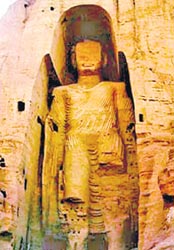
Debating the future of Afghan BuddhasSeven years ago, it was a place of serene contemplation. Now it is a vast, gaping chasm, filled with dust, noise and what looks like rubble, with signs warning that hard hats must be worn. This is the niche which used to house the world's tallest Buddha - 55 metres high. In it you can still see slight swellings where its feet used to be, and ghostly traces of where the head and neck were.
In the early morning light, a huge bulldozer shifts massive blocks of the destroyed colossus, already labelled and classified, into undercover storage at the edge of the site. Others, weighing 25 tonnes or even more, were moved earlier by crane. In a tiny cavern, local men are sawing away, making the wooden frames on which the pieces are being stored after they are moved. What is going on here, and in the niche of the 38-metre smaller Buddha half a kilometre away, is emergency action: to protect the pieces of the statues, and to support the massive cliff walls, weakened by the Taleban's explosions. Debating the future For some people, it was the dynamiting of the two giant Buddhas in March 2001 that really opened their eyes to the Taleban's extraordinary politics. They were built in the 6th century AD, when Bamiyan was a Buddhist trading post. Over the centuries they had suffered much destruction. But the Taleban, with their denunciation of idols, finished them off. Now a debate on the statues' future is under way -- as to whether they could, or should, be rebuilt. Since their destruction, the UN's cultural organisation, UNESCO, has designated them as a World Heritage Site, so it, too, has a say in the matter. Georgios Toubekis of the International Council on Monuments and Sites took me round the site of the larger Buddha. He and his colleagues are sorting through the debris and identifying, in particular, the pieces which show the sculpted surface of the Buddhas. He shows me some key pieces. There is one where a fold of the Buddha's garment has been directly carved onto the cliff. Mostly, the clothes were moulded from a mix of plaster and straw and added afterwards. Over-optimistic On other pieces you can see the holes into which the sculptors placed the wooden pegs which were then connected with ropes and daubed with plaster. Geologists are analysing the rock strata to identify where the pieces belonged in the original statues. "There is still a remarkable amount left," says Mr Toubekis. "We would say that most of the stone pieces are still here." That may be over-optimistic, as a large portion of the statues was pulverised into dust. But some form of rebuilding may be feasible. The experts may in time work out where all the surviving pieces belong and succeed in putting them back, holding them together with as little new material as possible. That could fulfil UNESCO’s criteria, which outlaw any actual new building work. Mr. Toubekis, however, is non-committal on whether he favours reconstruction. It is as if he wants Afghans to decide. Nasir Mudabir, a young local man, vividly remembers hearing of the destruction from exile in Pakistan. 'Felt sad' He and his family had fled there after their relatives were killed by the Taleban, being Shia Muslims of the ethnic Hazara community which predominates in Bamiyan."There was a picture of Buddha during the destruction, dust and fire and everything," he says."When I saw the Buddha was destroyed I felt very sad. Very, very sad." Mr. Mudabir is now director of historic monuments for Bamiyan. But he doesn't believe in reconstruction. He wants the ruins to be left as a reminder of what happened, with small-scale replicas made instead."If we reconstruct the Buddha, it is not the real Buddha it was before," he says."If we reconstruct, we destroy the history of the destruction by the Taleban." Others say rebuilding the statues would simply be a waste of money in a poverty-stricken province. But many disagree. Bamiyan town is alive again after years of suffering. In the main bazaar street, the view is dominated by the empty gaps where the Buddhas once stood, with pinkish greyish cliffs above and a jagged skyline ridge. 'Very good' In the streets it is impossible to find anyone who wants to leave the ruins alone."They should rebuild the Buddhas because this is a historic thing of Bamiyan and Afghanistan," says grocer Said Ahmedullah. Rohullah Moussavi, a youth, agrees. Reconstruction would be "very good for the people of Bamiyan, even for Afghanistan, even for the world", he says. The governor of Bamiyan Province, Habiba Sarabi, also advocates reconstruction of at least one of the Buddhas. She says the statues were part of the life of local people and that rebuilding will create jobs and help tourism. The fact that they were built for Buddhist veneration is, she says, not a problem. But it could be a long time before a decision either way is reached. Every December, UNESCO meets the Afghan government to reconsider the feasibility or desirability of rebuilding the Buddhas, based on what the experts are discovering about the ruins. For a good while yet, the two empty chasms will continue to dominate Bamiyan. BBC |
|| Front
Page | News | Editorial | Columns | Sports | Plus | Financial
Times | International | Mirror | TV
Times | Funday
Times || |
| |
Copyright
2007 Wijeya
Newspapers Ltd.Colombo. Sri Lanka. |
